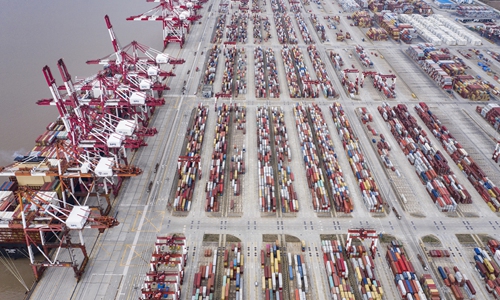Significance of Yangtze River Delta development strengthened in post-virus era
By Zhang Dan Source: Global Times Published: 2020/8/23 21:48:24
Significance of Yangtze River Delta strengthened

Shipping containers are stacked next to grand cranes at the Yangshan Deep Water Port in East China's Shanghai. About 70 percent of cargoes from the Yangtze River Delta are transported overseas from this port, which is home to the world's largest fully automated terminal. Photo: VCG
The integrated and high-quality development of the Yangtze River Delta region, which drives nearly one-quarter of China's GDP growth, will play a more significant role in the economy's revival amid a global recession and escalating tensions with the US.
Chinese President Xi Jinping has stressed efforts to seek continuous results in the integration of the Yangtze River Delta through focusing on the work of integrated and high-quality development. Xi made the remarks at a symposium in Hefei, East China's Anhui Province on Thursday, according to the Xinhua News Agency.
The integration mechanism and interconnected infrastructure have played a role in epidemic prevention and control as well as economic recovery, Xi said.
Surprisingly, the performance of the region in the first half, beleaguered by the epidemic, was better than in 2019, with the region's combined GDP as a percentage of national GDP rising to 24.25 percent in the first half from 23.9 percent for the whole of 2019.
During the coronavirus outbreak in China, Shanghai coordinated more than 300 local enterprises to resume production and provide supporting facilities for the industrial chain in the three provinces in the region.
"The numbers implied that under mounting pressure at home and abroad, the economic contribution made by the Yangtze River Delta region was more prominent and evident than before the outbreak. That will enable the region to play a bigger role in continuing the development trend," He Fei, a senior research fellow with the Bank of Communications, told the Global Times Sunday.
Taking the burgeoning technology sector as an example, He suggested the region summon its forces and play to its advantages to mature the whole region's industrial chain.
"For instance, [enterprises can] put their research and development operations in Shanghai, their manufacturing in Anhui and their application scenarios in other places, to form a well-established chain centered on science and technology innovation."
For example, Chinese PC maker Lenovo told the Global Times that relying on the favorable policies, established infrastructure and talent resources provided by the Pudong New Area and Zhangjiang Hi-Tech Park, the company can make innovations in its laptop products, while providing a supply chain and technical services to its customers.
In Hefei city, Lenovo has established its largest PC R&D and manufacturing base, winning the title of "the Largest Import and Export Enterprise in Anhui Province" for six consecutive years.
Boasting a talent hub, a complete industrial chain and a high level of technology development, the region's advanced manufacturing also shows its vital role in stabilizing China's economy and employment market, He noted.
After the COVID-19 epidemic was contained in China, China Tiesiju Civil Engineering Group accelerated its key construction projects. Based in Anhui, the company wants to seize the opportunity to develop the Yangtze River Delta region by building railways and highways to facilitate the region's connectivity.
For instance, the Hangzhou West junction station, built by the company and known as a key part of the "Delta on track" high-speed railways, will allow passengers to travel from Wenzhou to Hangzhou within one hour.
Newspaper headline: Significance of Yangtze River Delta strengthened
Posted in: ECONOMY